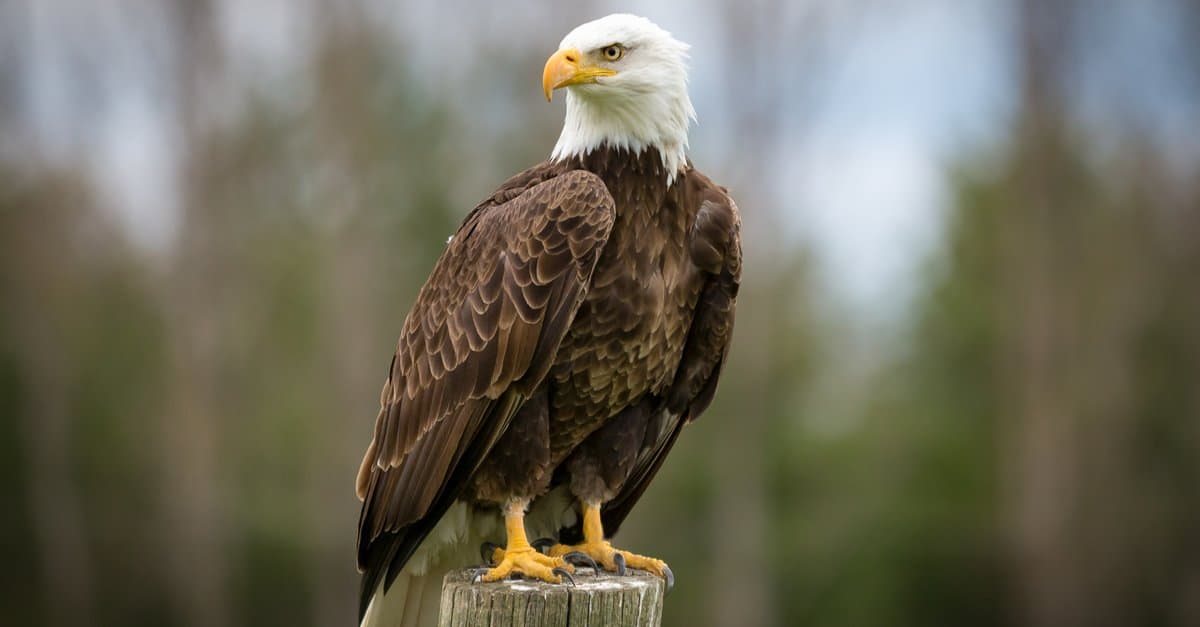Bald eagles are known for powerful, fast attacks that overwhelm their prey before they have a chance to fight back. They are not the largest, deadliest eagles, but they are known for taking snakes as prey. That doesn’t mean they can kill any snake in the world, though. Today, we’re going to look at what would happen in an epic bout between a king cobra vs. a bald eagle.
We’ll break down the strengths and weaknesses of these two animals and show you exactly what would happen if this regal bird and deadly snake battled.
Comparing a King Cobra and a Bald Eagle
| King Cobra | Bald Eagle | |
|---|---|---|
| Size | Weight: between 10 and 15 pounds Length: 10 to 19 feet | Weight: 6-14 pounds Length: 2.5 to 3.3 feet Wingspan: up to 7.5 feet |
| Speed | Up to 5 mph over short distances Striking speed is much faster | 75-100 mph when diving Flies at about 30 mph |
| Defenses | Its coloration and patterns on the hood frighten some animals Can hide in small areas May camouflage in some settings | The ability to fly helps it stay away from predators Great senses help it spot movement from far away |
| Offensive Capabilities | Can lift its body when preparing to strike so it can attack vulnerable areas Has fangs that measure 0.5 inches May deliver 500 mg of deadly neurotoxic venom per bite A single bite has enough venom to kill 11 humans | Has a long, curved beak that measures almost 3 inches at their largest Has eight talons that measure about 2 inches long Very powerful gripping strength in their feet May carry prey weighing upwards of 5 or 6 pounds |
| Predatory Behavior | They are ambush predators that lie in wait for their prey and then attack They usually bite and release their prey and wait for it to die | Ambush predators that spot prey from far off and strike from the sky Grasp prey with one foot and tear at it with the other |
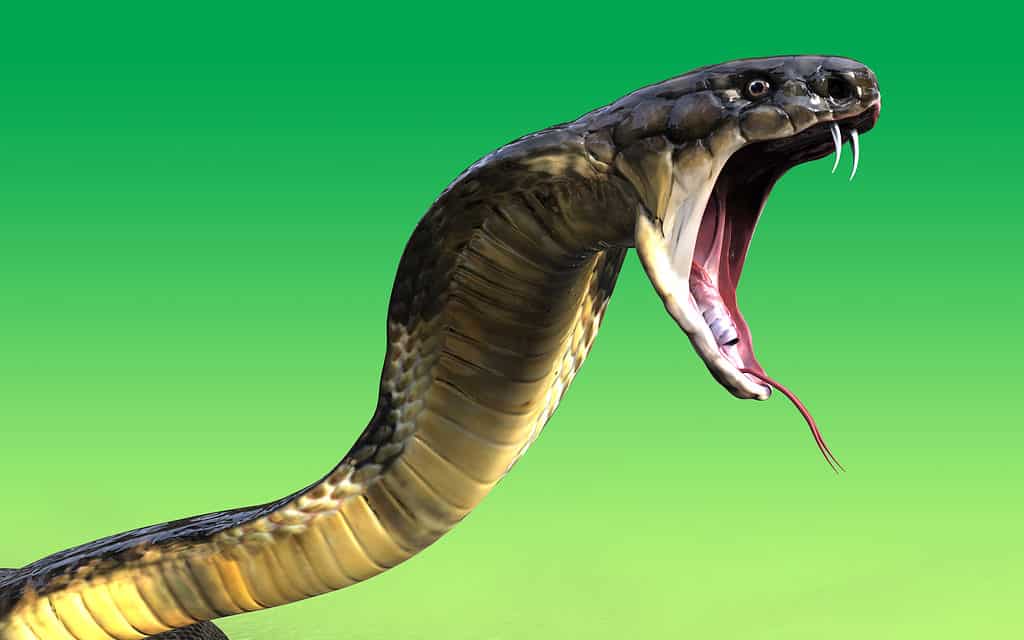
The king cobra’s fangs are half an inch in length.
©mrjo/Shutterstock.com
What Are the Key Differences Between a King Cobra and a Bald Eagle?
The most significant differences between a king cobra and a bald eagle can be found in their bodies and attacking methods. King cobras are the largest venomous snakes alive today with long, scaly bodies. They kill their prey by injecting them with venom, waiting for them to die, and swallowing them whole.
Meanwhile, bald eagles are raptors that typically hunt fish by performing a high-speed diving maneuver that allows them to dig their talons into prey and tear them to pieces in a sudden, deadly attack.
These differences will greatly impact a fight. However, these are not the only factors that will make a difference here. We’ll need more data before crowning one of these animals the winner.
Where Do They Live?
King Cobras can be found in different areas of Southeast Asia, such as India, China, and other countries in that area of the continent. They live in plains and rainforests.
Bald Eagles, on the other hand, live throughout the continent of North America. They are notably the national bird of the United States and a symbol of freedom.
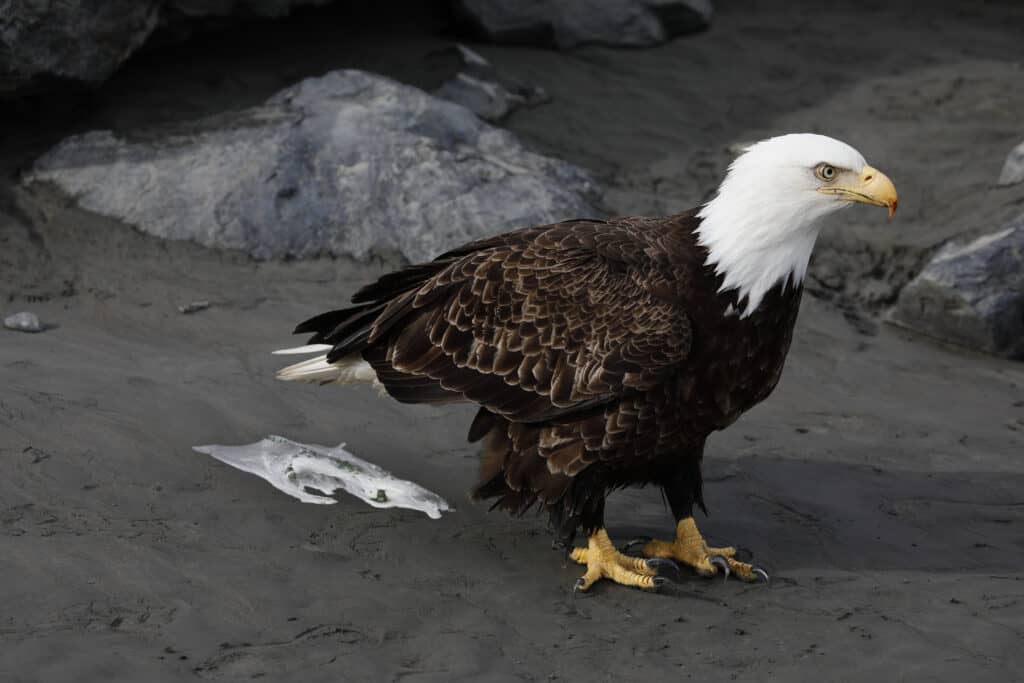
Bald eagles are raptors that typically hunt fish by performing a high-speed diving maneuver.
©iStock.com/R Lolli Morrow
What Are the 5 Key Factors in a Fight Between a King Cobra and a Bald Eagle?
The most significant factors in a battle between a king cobra and a bald eagle can be found in their size, speed, and offensive capabilities. To figure out which animal has the higher chance of emerging victorious, we’ll need to explore each of those elements. Yet, we also have to examine other related data as well, like defenses and how each animal initiates combat.
We’re going to examine five key factors in this fight, show which creature has the advantage, and then use that information to conclude whether the bald eagle or king cobra will win the battle.
Size
King cobras are larger than bald eagles. The average bald eagle weighs between 6 and 14 pounds, grows 3.3 feet in body length, and has a wingspan that measures up to 7.5 feet. They can grow between 10 and 19 feet long. Additionally, they can weigh between 10 and 15 pounds. This weight range is important because bald eagles can only fly away with something that weighs about 5 to 6 pounds on average.
King cobras have the size advantage in this fight.

Speed
Bald eagles are much faster than king cobras when attacking. Bald eagles average about 30 mph when flying fast, but their diving speed is faster. When diving to attack prey, like fish, they can reach speeds of 100 mph. They can strike their prey before the animal knows what’s happening.
King cobras only move at speeds of about 5 mph over short distances. They’re not known for their speed. Yet, the speed of their strike is impressive, and they can successfully land bites on especially agile creatures like the mongoose.
Bald eagles have the speed advantage in this fight.
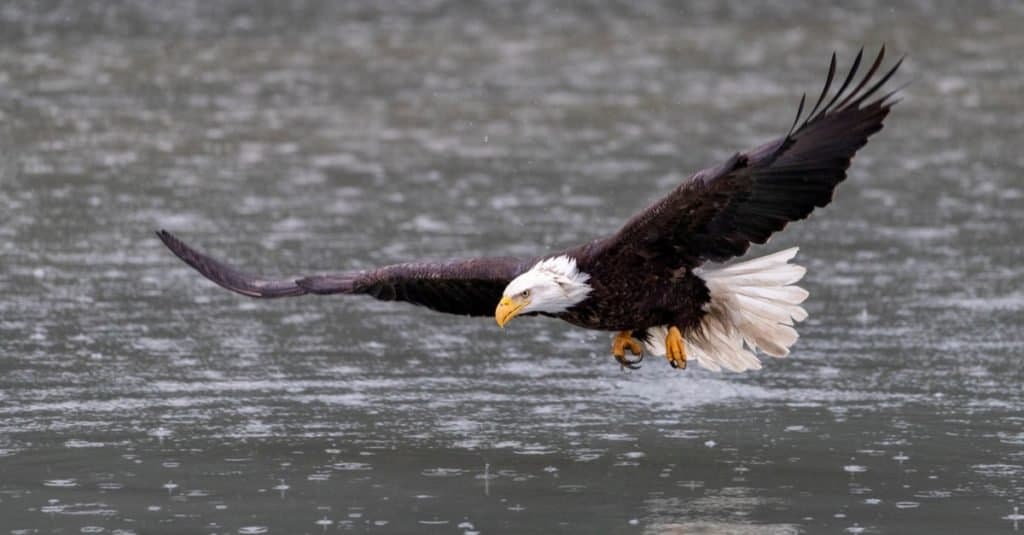
When diving to attack prey, bald eagles can reach speeds of 100 mph.
©Dennis W Donohue/Shutterstock.com
Defenses
The king cobra and bald eagle have limited defenses. Neither of these animals are armored beings that can withstand a lot of punishment. Instead, the king cobra can squeeze into small places or hide in tall grass. Meanwhile, bald eagles can use their incredible senses to spot danger from afar and flee the area by taking to the skies.
Yet, neither animal has enough defenses to negate an attack from the other creature. So, whoever scores the first blow will have a better chance of winning.
The king cobra and bald eagle are tied for their defenses.
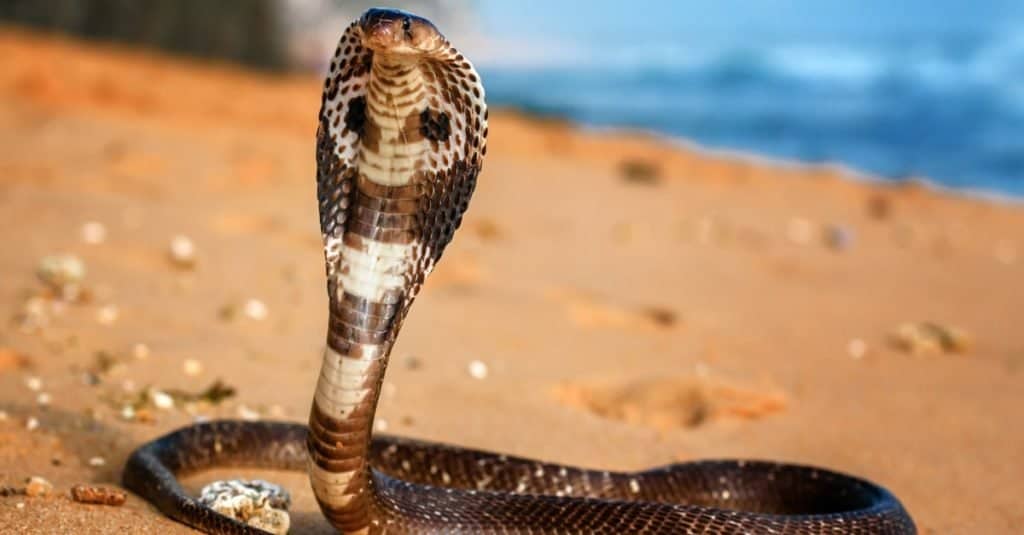
The king cobra can squeeze into small places or hide in tall grass.
©Vova Shevchuk/Shutterstock.com
Offensive Capabilities
Bald eagles attack their prey from the air. They’ll dive at their prey and dig into them by using their 2-inch-long talons. They dig into their prey and hold it still while their beak tears into the animal’s body. Their beaks measure about 3 inches in total length and they’re capable of tearing flesh with ease.
The attack often cuts into small animals’ organs while the eagle bites the animal’s head. The bald eagle has very powerful feet, and it can lift a 6-pound animal off the ground and fly away with it.
Meanwhile, king cobras use their powerful neurotoxic venom to kill their foes. They can inject anywhere from 500 mg to 1,000 mg into their prey, causing them to go into respiratory failure. These snakes can lift upwards of one-third of their bodies off the ground, giving them the reach advantage over other animals when fighting on the ground. Incredibly, a single bite from this snake has enough venom to kill 11 humans.
Both animals have incredibly powerful offensive capabilities, but only the bald eagle can kill instantly.

The bald eagle has very powerful feet, and it can lift a 6-pound animal off the ground and fly away with it.
©PHOTOOBJECT/Shutterstock.com
Predatory Behavior
Both the bald eagle and the king cobra are ambush predators. That means they wait for the opportune moment to kill their prey and attack with stealth. King cobras will wait in tall vegetation or in crevices to strike. Meanwhile, bald eagles attack from the air.
King cobras only need to land a single bite to put down prey, but their venom takes time to work. In contrast, the bald eagle can kill in mere seconds.
Who Would Win in a Fight Between a King Cobra and a Bald Eagle?
A bald eagle would win a fight against a king cobra. Bald eagles are used to killing snakes. While the king cobra is too large for the bald eagle to snatch up in its talons and fly away with, it can still land a devastating, oft-fatal attack from the air before the king cobra can respond.
If the bald eagle spotted the king cobra slithering through grass or down a dirt path, all it would have to do is divebomb the large snake and aim for its head. The last place a king cobra would look is above, and that’s where an eagle attack comes from. The bald eagle could then drive the bird’s talons into the snake’s vital areas and tear into its head.
Of course, if this attack was unsuccessful, the eagle would be in trouble. Likewise, if the eagle tried to carry the snake off, the king cobra could always retaliate and bite. If the bald eagle failed to secure the kill outright, it would probably leave after testing the snake’s speed and agility.
In contrast, the chances of the king cobra attacking a bald eagle from stealth are very small. Aside from the fact that the animals don’t share a habitat, king cobras don’t slither quite as high as bald eagles build their nests.
Thus, in this particular fight, the odds seem to favor the bald eagle landing a killing blow from above more than they favor the surprised king cobra turning the tables on its aggressor.
Lifespan: Which Lives Longer, the Bald Eagle or the King Cobra?
Looks like the bald eagle is the winner at lifelength as well, though the king cobra isn’t far behind. The average life expectancy for a king cobra is around 20 years in the wild. The bald eagle, however, averages 20-30 years in the wild, and it can possibly make it to 50-plus years in captivity.
What are 5 Interesting Facts About Bald Eagles?
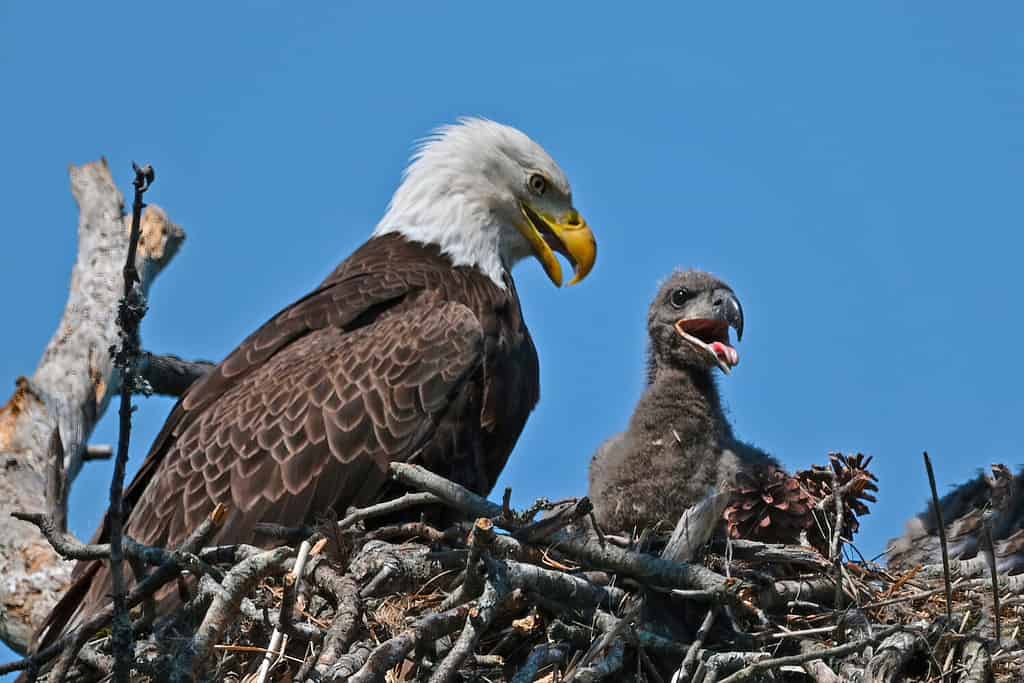
Did you know that bald eagles can reach 100 miles per hour when diving?
©Brian E Kushner/Shutterstock.com
- Bald eagles are the national bird of the United States and they appear on many official documents, seals, and logos.
- These majestic birds have a wingspan of up to 7 feet! This is one of the largest wingspans of any North American bird.
- Bald eagles can fly at speeds up to 40 miles per hour while hunting for food or migrating south in winter months. When it is diving, it can reach 100 miles per hour!
- The bald eagle’s diet consists mainly of fish, but it also eats small mammals and birds. It has even been known to scavenge carrion if necessary.
- The bald eagle was removed from the U.S. Endangered Species List in June of 2007, after being on the list for over 40 years due to habitat destruction and hunting practices that threatened its numbers in North America.
What are 5 Interesting Facts about King Cobras?
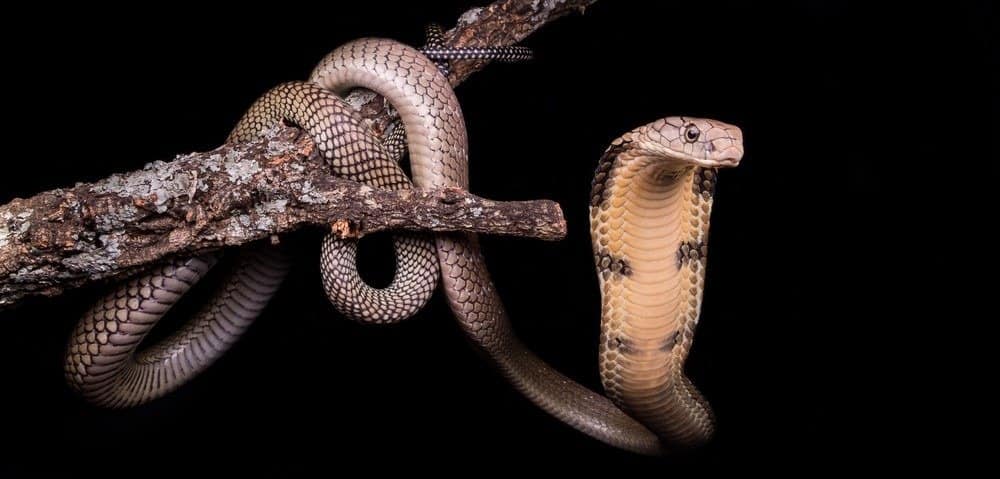
King cobra in a tree
©Sibons photography/Shutterstock.com
- King cobras are the longest venomous snakes in the world, growing up to 18 feet long!
- The king cobra’s diet consists mostly of other snakes, including rat snakes and even small cobras. It also eats lizards, frogs, birds, and small mammals.
- They have a unique hood that they can flare out when threatened or attacking prey. This helps intimidate predators as well as protect their heads from potential harm during battles with other
- King cobras have a unique ability to climb trees, and they’re also great swimmers. This allows them to hunt for food in both terrestrial and aquatic environments.
- The king cobra is actually immune to its own venom! It has developed an immunity over time so that it can consume other snakes without being harmed by their venomous bites.
Thank you for reading! Have some feedback for us? Contact the AZ Animals editorial team.

